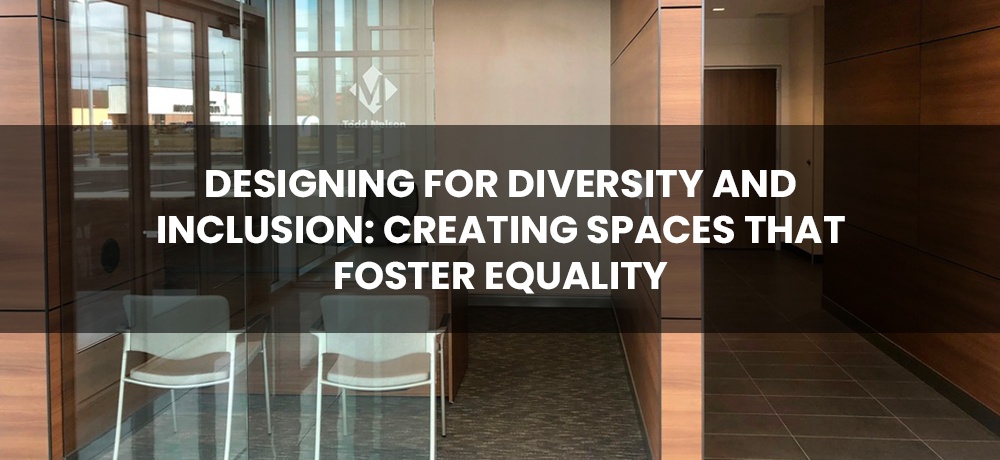Designing for Diversity and Inclusion: Creating Spaces that Foster Equality

In today's diverse and inclusive workplaces, designing office spaces that promote equality and foster a sense of belonging is essential. By creating environments that embrace diversity and cater to the needs of all employees, businesses can cultivate an inclusive culture where everyone feels valued and empowered. In this blog post, we will explore the importance of designing for diversity and inclusion and discuss key considerations for creating spaces that foster equality.
1.) Embracing a Multicultural and Inclusive Design Approach:
Designing for diversity and inclusion starts with embracing a multicultural perspective in the design process. Recognize and respect the diverse backgrounds, cultures, and perspectives of your employees. Incorporate elements of inclusivity in the choice of materials, colors, artwork, and furniture to reflect a variety of cultural influences. By celebrating diversity through design, you create an environment that welcomes and respects individuals from all walks of life.
2.) Creating Spaces for Collaboration and Interaction:
Promoting equality in office design involves creating spaces that facilitate collaboration and interaction among employees. Provide open and flexible areas where teams can come together, exchange ideas, and work collectively. Consider incorporating diverse seating options, such as communal tables, breakout spaces, and comfortable lounge areas, to accommodate different work styles and preferences. By encouraging collaboration, you foster a sense of equality and ensure that everyone's voice is heard and valued.
3.) Prioritizing Accessibility and Universal Design:
An inclusive workspace is one that is accessible to everyone, regardless of physical ability. Incorporate universal design principles to ensure that your office spaces are accessible and usable by individuals with diverse needs. Consider features such as wheelchair ramps, adjustable workstations, ergonomic furniture, and clear signage for easy navigation. By prioritizing accessibility, you create an environment where everyone can fully participate and contribute.
4.) Offering Choice and Personalization:
Designing for equality means providing employees with the freedom to personalize their workspace according to their preferences and needs. Offer a range of furniture options, adjustable desk heights, and storage solutions that allow individuals to create a space that reflects their identity and supports their work style. Encourage employees to add personal touches, such as photos or artwork, to their workstations. By offering choice and personalization, you acknowledge and respect individual differences, fostering a sense of equality and ownership.
5.) Considering Sensory Needs and Well-being:
Inclusive office design takes into account the sensory needs of employees. Create spaces that address various sensory sensitivities, such as providing quiet zones for individuals who require a calm and focused environment, or incorporating sound-absorbing materials to reduce noise levels. Pay attention to lighting levels, offering options for natural light and adjustable lighting to accommodate different preferences. By considering sensory needs, you create a supportive and inclusive environment that promotes well-being for all.
6.) Implementing Gender-Neutral Spaces:
Gender-neutral spaces are an important aspect of inclusive design. Provide gender-neutral restrooms and designate lactation rooms that are inclusive and accessible to all employees. Consider creating breakout areas or wellness rooms that serve as safe and inclusive spaces for diverse needs. By implementing gender-neutral spaces, you demonstrate a commitment to inclusivity and eliminate potential barriers or discomfort faced by certain individuals.
7.) Emphasizing Psychological Safety:
Psychological safety is vital for fostering equality and inclusion. Design spaces that promote psychological safety by incorporating elements that encourage open communication, respect, and trust. Include comfortable meeting areas with inclusive seating arrangements that facilitate equitable participation. Create informal gathering spaces where employees can engage in authentic conversations and build connections. By designing for psychological safety, you create an environment where everyone feels valued, respected, and comfortable expressing themselves.
Designing for diversity and inclusion is crucial for creating office spaces that foster equality and empower all employees. By embracing a multicultural and inclusive design approach, creating spaces for collaboration, prioritizing accessibility, offering choice and personalization, considering sensory needs, implementing gender-neutral spaces, and emphasizing psychological safety, businesses can create environments where everyone feels welcome, valued, and empowered. A truly inclusive workspace promotes equality, diversity, and belonging, ultimately leading to increased employee engagement, creativity, and overall success.